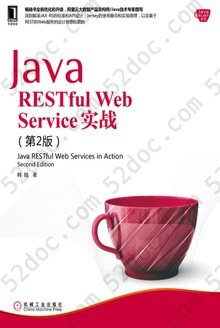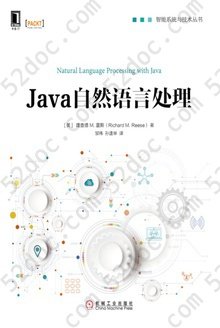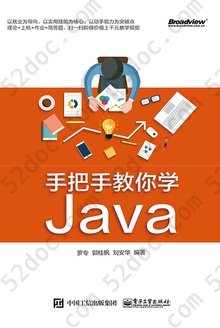注重体验与质量的电子书资源下载网站
分类于: 互联网 其它
简介

RxJava反应式编程(影印版 英文版) 豆 0.0分
资源最后更新于 2020-10-25 12:19:47
作者:Tomasz Nurkiewicz
出版社:东南大学出版社
出版日期:2017-01
ISBN:9787564173708
文件格式: pdf
简介· · · · · ·
在今天这个手机APP驱动的时代,程序的异步性和响应性至关重要,响应式编程能帮助你编写更可靠、更易伸缩且性能更好的代码。在《RxJava反应式编程(影印版 英文版)》这本务实的书中,Java开发者首先会学习到如何用反应式视角看待问题,然后再借助这一令人兴奋的全新编程范式所提供的优秀特性构建应用程序。
作者Tomasz Nurkiewicz(托马什·勒克威茨)和Ben Christensen(本·克斯藤森)引入了使用RxJava库的具体例子,解决安卓设备和服务端上的真实性能问题。你会学到RxJava如何利用并行和并发来帮助我们解决今天的问题。
《RxJava反应式编程(影印版 英文版)》同时也提供了即将发布的2.0版本的预览。
目录
Foreword
Introduction
1. Reactive Programming with RxJava
Reactive Programming and RxJava
When You Need Reactive Programming
How RxJava Works
Push versus Pull
Async versus Sync
Concurrency and Parallelism
Lazy versus Eager
Duality
Cardinality
Mechanical Sympathy: Blocking versus Nonblocking I/O
Reactive Abstraction
2. Reactive Extensions
Anatomy of rx.Observable
Subscribing to Notifications from Observable
Capturing All Notifications by Using Observer
Controlling Listeners by Using Subscription and Subscriber
Creating Observables
Mastering Observable.create0
Infinite Streams
Timing: timer() and interval()
Hot and Cold Observables
Use Case: From Callback API to Observable Stream
Manually Managing Subscribers
rx.subjects.Subject
ConnectableObservable
Single Subscription with publishO.refCountO
ConnectableObservable Lifecycle
Summary
3. Operators and Transformations
Core Operators: Mapping and Filtering
1-to-1 Transformations Using map()
Wrapping Up Using flatMap0
Postponing Events Using the delay() Operator
Order of Events After flatMap0
Preserving Order Using concatMap0
More Than One Observable
Treating Several Observables as One Using merge()
Pairwise Composing Using zip() and zipWith()
When Streams Are Not Synchronized with One Another: combineLatest(),
withLatestFrom(), and amb()
Advanced Operators: collect(), reduce(), scan(), distinct(), and groupBy()
Scanning Through the Sequence with Scan and Reduce
Reduction with Mutable Accumulator: collect()
Asserting Observable Has Exactly One Item Using single()
Dropping Duplicates Using distinct() and distinctUntilChanged()
Slicing and Dicing Using skip(), takeWhile(), and Others
Ways of Combining Streams: concat(), merge(), and switchOnNext()
Criteria-Based Splitting of Stream Using groupBy0
Where to Go from Here?
Writing Customer Operators
Reusing Operators Using compose()
Implementing Advanced Operators Using lift()
Summary
4. Applying Reactive Programming to Existing Applications
From Collections to Observables
BlockingObservable: Exiting the Reactive World
Embracing Laziness
Composing Observables
Lazy paging and concatenation
Imperative Concurrency
flatMap0 as Asynchronous Chaining Operator
Replacing Callbacks with Streams
Polling Periodically for Changes
Multithreading in RxJava
What Is a Scheduler?
Declarative Subscription with subscribeOn()
subscribeOn0 Concurrency and Behavior
Batching Requests Using groupBy()
Declarative Concurrency with observeOn()
Other Uses for Schedulers
Summary
5. Reactive from Top to Bottom
Beating the C1Ok Problem
Traditional Thread-Based HTTP Servers
Nonblocking HTTP Server with Netty and RxNetty
Benchmarking Blocking versus Reactive Server
Reactive HTTP Servers Tour
HTTP Client Code
Nonblocking HTTP Client with RxNetty
Relational Database Access
NOTIFY AND LISTEN on PostgreSQL Case Study
CompletableFuture and Streams
A Short Introduction to CompletableFuture
Interoperability with CompletableFuture
Observable versus Single
Creating and Consuming Single
Combining Responses Using zip, merge, and concat
Interoperability with Observable and CompletableFuture
When to Use Single?
Summary
6. Flow Control and Backpressure
Flow Control
Taking Periodic Samples and Throttling
Buffering Events to a List
Moving window
Skipping Stale Events by Using debounce()
Backpressure
Backpressure in RxJava
Built-in Backpressure
Producers and Missing Backpressure
Honoring the Requested Amount of Data
Summary
7. Testing and Troubleshooting
Error Handling
Where Are My Exceptions?
Declarative try-catch Replacement
Timing Out When Events Do Not Occur
Retrying After Failures
Testing and Debugging
Virtual Time
Schedulers in Unit Testing
Unit Testing
Monitoring and Debugging
doOn...() Callbacks
Measuring and Monitoring
Summary
8. Case Studies
Android Development with RxJava
Avoiding Memory Leaks in Activities
Retrofit with Native RxJava Support
Schedulers in Android
UI Events as Streams
Managing Failures with Hystrix
The First Steps with Hystrix
Nonblocking Commands with HystrixObservableCommand
Bulkhead Pattern and Fail-Fast
Batching and Collapsing Commands
Monitoring and Dashboards
Querying NoSQL Databases
Couchbase Client API
MongoDB Client API
Camel Integration
Consuming Files with Camel
Receiving Messages from Kafka
Java 8 Streams and CompletableFuture
Usefulness of Parallel Streams
Choosing the Appropriate Concurrency Abstraction
When to Choose Observable?
Memory Consumption and Leaks
Operators Consuming Uncontrolled Amounts of Memory
Summary
9. Future Directions
Reactive Streams
Observable and Flowable
Performance
Migration
A. More HTTP Server Examples
B. A Decision Tree of Observable Operators
Index
Introduction
1. Reactive Programming with RxJava
Reactive Programming and RxJava
When You Need Reactive Programming
How RxJava Works
Push versus Pull
Async versus Sync
Concurrency and Parallelism
Lazy versus Eager
Duality
Cardinality
Mechanical Sympathy: Blocking versus Nonblocking I/O
Reactive Abstraction
2. Reactive Extensions
Anatomy of rx.Observable
Subscribing to Notifications from Observable
Capturing All Notifications by Using Observer
Controlling Listeners by Using Subscription and Subscriber
Creating Observables
Mastering Observable.create0
Infinite Streams
Timing: timer() and interval()
Hot and Cold Observables
Use Case: From Callback API to Observable Stream
Manually Managing Subscribers
rx.subjects.Subject
ConnectableObservable
Single Subscription with publishO.refCountO
ConnectableObservable Lifecycle
Summary
3. Operators and Transformations
Core Operators: Mapping and Filtering
1-to-1 Transformations Using map()
Wrapping Up Using flatMap0
Postponing Events Using the delay() Operator
Order of Events After flatMap0
Preserving Order Using concatMap0
More Than One Observable
Treating Several Observables as One Using merge()
Pairwise Composing Using zip() and zipWith()
When Streams Are Not Synchronized with One Another: combineLatest(),
withLatestFrom(), and amb()
Advanced Operators: collect(), reduce(), scan(), distinct(), and groupBy()
Scanning Through the Sequence with Scan and Reduce
Reduction with Mutable Accumulator: collect()
Asserting Observable Has Exactly One Item Using single()
Dropping Duplicates Using distinct() and distinctUntilChanged()
Slicing and Dicing Using skip(), takeWhile(), and Others
Ways of Combining Streams: concat(), merge(), and switchOnNext()
Criteria-Based Splitting of Stream Using groupBy0
Where to Go from Here?
Writing Customer Operators
Reusing Operators Using compose()
Implementing Advanced Operators Using lift()
Summary
4. Applying Reactive Programming to Existing Applications
From Collections to Observables
BlockingObservable: Exiting the Reactive World
Embracing Laziness
Composing Observables
Lazy paging and concatenation
Imperative Concurrency
flatMap0 as Asynchronous Chaining Operator
Replacing Callbacks with Streams
Polling Periodically for Changes
Multithreading in RxJava
What Is a Scheduler?
Declarative Subscription with subscribeOn()
subscribeOn0 Concurrency and Behavior
Batching Requests Using groupBy()
Declarative Concurrency with observeOn()
Other Uses for Schedulers
Summary
5. Reactive from Top to Bottom
Beating the C1Ok Problem
Traditional Thread-Based HTTP Servers
Nonblocking HTTP Server with Netty and RxNetty
Benchmarking Blocking versus Reactive Server
Reactive HTTP Servers Tour
HTTP Client Code
Nonblocking HTTP Client with RxNetty
Relational Database Access
NOTIFY AND LISTEN on PostgreSQL Case Study
CompletableFuture and Streams
A Short Introduction to CompletableFuture
Interoperability with CompletableFuture
Observable versus Single
Creating and Consuming Single
Combining Responses Using zip, merge, and concat
Interoperability with Observable and CompletableFuture
When to Use Single?
Summary
6. Flow Control and Backpressure
Flow Control
Taking Periodic Samples and Throttling
Buffering Events to a List
Moving window
Skipping Stale Events by Using debounce()
Backpressure
Backpressure in RxJava
Built-in Backpressure
Producers and Missing Backpressure
Honoring the Requested Amount of Data
Summary
7. Testing and Troubleshooting
Error Handling
Where Are My Exceptions?
Declarative try-catch Replacement
Timing Out When Events Do Not Occur
Retrying After Failures
Testing and Debugging
Virtual Time
Schedulers in Unit Testing
Unit Testing
Monitoring and Debugging
doOn...() Callbacks
Measuring and Monitoring
Summary
8. Case Studies
Android Development with RxJava
Avoiding Memory Leaks in Activities
Retrofit with Native RxJava Support
Schedulers in Android
UI Events as Streams
Managing Failures with Hystrix
The First Steps with Hystrix
Nonblocking Commands with HystrixObservableCommand
Bulkhead Pattern and Fail-Fast
Batching and Collapsing Commands
Monitoring and Dashboards
Querying NoSQL Databases
Couchbase Client API
MongoDB Client API
Camel Integration
Consuming Files with Camel
Receiving Messages from Kafka
Java 8 Streams and CompletableFuture
Usefulness of Parallel Streams
Choosing the Appropriate Concurrency Abstraction
When to Choose Observable?
Memory Consumption and Leaks
Operators Consuming Uncontrolled Amounts of Memory
Summary
9. Future Directions
Reactive Streams
Observable and Flowable
Performance
Migration
A. More HTTP Server Examples
B. A Decision Tree of Observable Operators
Index








